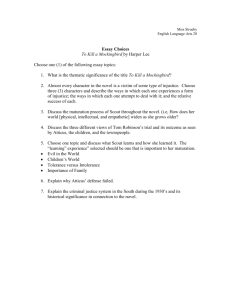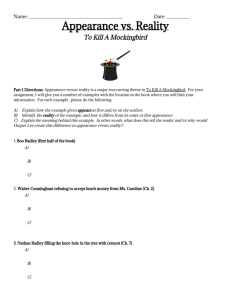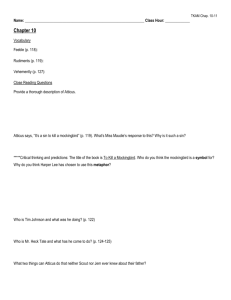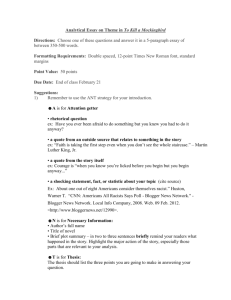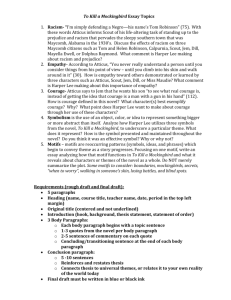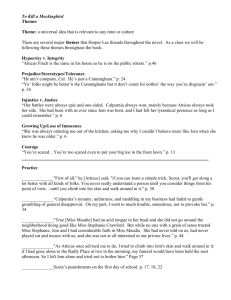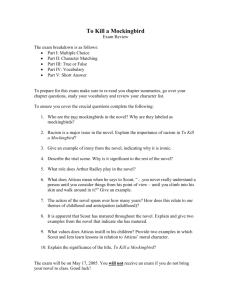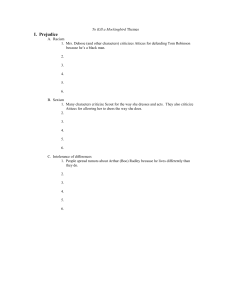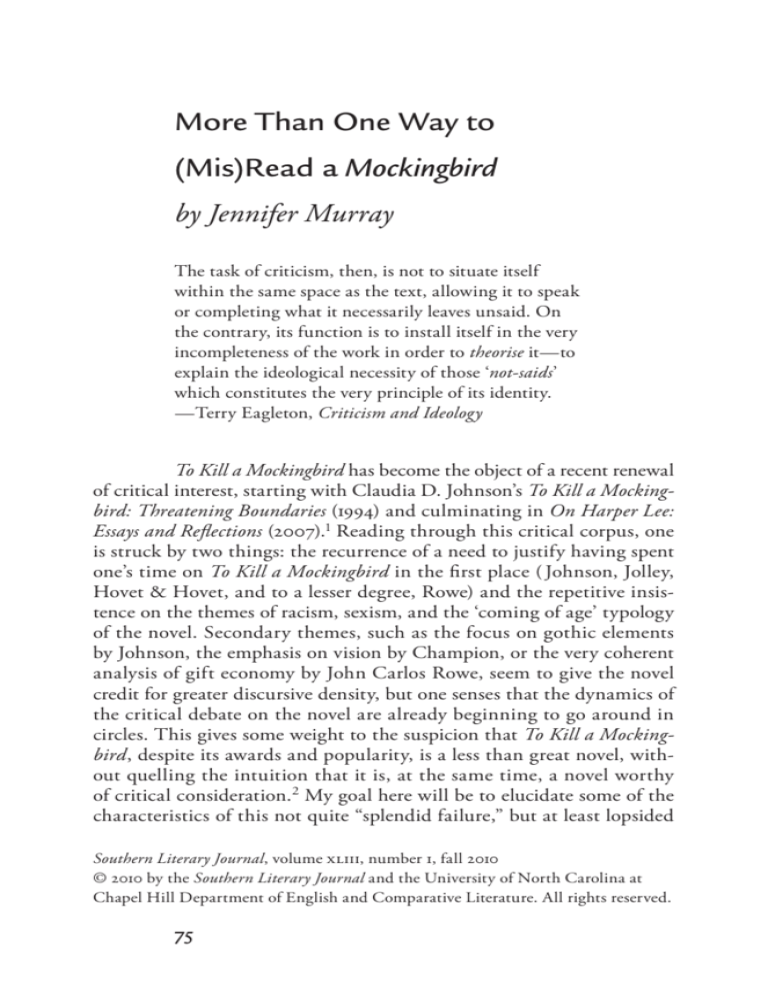
More Than One Way to
(Mis)Read a Mockingbird
by Jennifer Murray
The task of criticism, then, is not to situate itself
within the same space as the text, allowing it to speak
or completing what it necessarily leaves unsaid. On
the contrary, its function is to install itself in the very
incompleteness of the work in order to theorise it — to
explain the ideological necessity of those ‘not-­saids’
which constitutes the very principle of its identity.
— Terry Eagleton, Criticism and Ideology
To Kill a Mockingbird has become the object of a recent renewal
of critical interest, starting with Claudia D. Johnson’s To Kill a Mockingbird: Threatening Boundaries (1994) and culminating in On Harper Lee:
Essays and Reflections (2007).1 Reading through this critical corpus, one
is struck by two things: the recurrence of a need to justify having spent
one’s time on To Kill a Mockingbird in the first place ( Johnson, Jolley,
Hovet & Hovet, and to a lesser degree, Rowe) and the repetitive insistence on the themes of racism, sexism, and the ‘coming of age’ typology
of the novel. Secondary themes, such as the focus on gothic elements
by Johnson, the emphasis on vision by Champion, or the very coherent
analysis of gift economy by John Carlos Rowe, seem to give the novel
credit for greater discursive density, but one senses that the dynamics of
the critical debate on the novel are already beginning to go around in
circles. This gives some weight to the suspicion that To Kill a Mockingbird, despite its awards and popularity, is a less than great novel, without quelling the intuition that it is, at the same time, a novel worthy
of critical consideration.2 My goal here will be to elucidate some of the
characteristics of this not quite “splendid failure,” but at least lopsided
Southern Literary Journal, volume xliii, number 1, fall 2010
© 2010 by the Southern Literary Journal and the University of North Carolina at
Chapel Hill Department of English and Comparative Literature. All rights reserved.
75
76 Southern Literary Journal
achievement. To do so, I will interrogate those aspects of the text that are
radically open to interpretative debate, the knots and tangles in the work
that seem to indicate points of unresolved tension symptomatic of artistic
or ideological compromise.3 These fault-­lines that disrupt the evenness
of the writing are related to most aspects of the novel: its structural cohesion, the identification and status of a “main character,” and its ideological positioning in terms of race, class, and gender. What is fascinating
about these textual disturbances is that they do not necessarily give rise,
in recent criticism, to a questioning of the presuppositions or pressures
that produced them, but rather that they tend to fuel a process of disavowal: a refusal to see. In concrete terms, this is manifested by a critical
propensity to fill in the disturbing blanks, to smooth over contradictions,
or simply to misread the text.
Originating from a few short stories, To Kill a Mockingbird is first of
all the product of marketing pressures. In the mid–1950s, Harper Lee
showed the stories she had written about her childhood experiences to a
literary agent who “suggested that she consider going a step further by
weaving the stories into a novel . . . She attempted to do so in 1956 and
a year later, she had completed the first draft of To Kill a Mockingbird ”
(“Nelle”). The transformation of the stories into a novel was not immediately successful. Editors at Lippincott “criticized the novel’s structure,
which they felt read like a series of short stories strung together,” but “saw
promise in the book and encouraged Lee to rewrite it” (Chapman & Dear
270; qtd in Petry 160). Lee spent nearly three years modifying her work
to meet the editors’ requirements.
The first question this raises is: why was the transformation of short
stories into a novel considered to be “a step further”; why couldn’t the stories be published as short stories? Clearly the answer is that novels were
more marketable than short story collections. In his biography of Alice
Munro, Robert Thacker notes that in the 1950s and 1960s “it was a truism among publishers that [short story] collections did not sell, and that
they should be attempted only once an author’s reputation was already
established through the prior publication of a novel” (142). Thacker refers
to the despondency experienced by Munro in relation to pressures to produce a novel: “so much of the ‘constant despair’ Munro felt during the
late 1950s and into the 1960s was brought on by her ongoing response to
[the] question: ‘Have you begun work on a novel yet?’ ” (142 – 143).4 One
can imagine Harper Lee in similar despair when
More Than One Way to (Mis)Read a Mockingbird 77
one winter night in 1958 . . . trying to finesse her unruly, episodic
manuscript into some semblance of a cohesive novel [and all] but
drowning in multiple drafts of the same material, Lee suddenly
threw open a window and scattered five years of work onto the
dirty snow below. (“To Kill”)
The hierarchical valuing of the novel over the short story is also pointed
out in James Nagel’s The Contemporary American Short Story Cycle; he
notes that numerous short story cycles continue to be read as if they were
in fact novels, “the implicit assumption being that the novel is the highest form of expression in fiction, and the attribution of ‘novel’ to a work
of fiction is thus perceived as a compliment” (15).
The traces of this forced transformation of genre are clear in the novel;
its structure remains episodic rather than linear. When, as punishment
for decapitating her camellias, Jem is made to go read to that terrifying
and grotesque relic of the Southern Belle, Mrs. Henry Lafayette Dubose,
the episode is neither connected to other dominant aspects of plot, nor
does it advance the chronology of events. On the contrary, it is a finely
structured gothic episode which could stand on its own as a short story.
Likewise, even if the episode of the mad dog enriches Jem’s perception of
his father and reveals to him the value of modesty, it is not an element of
plot advancement. Satellitic, related through character and setting, and
privileging moments of experience, the chapters of To Kill a Mockingbird
resonate more with a short story cycle’s interconnectedness than the classical novel’s linear coherence.
Alice Hall Petry, the editor of the recent On Harper Lee: Essays and
Reflections, gives detailed evidence of this process of transformation,
including the editorial pressure on Lee to change genres (160). Yet Petry
does not draw the logical conclusion from her findings: in spite of the
proof of a long process of rewriting and alteration presented in the main
body of her article, she affirms that “although reportedly originating in
a series of related short stories, To Kill a Mockingbird seems to have come
out of nowhere as a complete novel” (146). The use of “reportedly” undermines the multi-­source evidence which is cited in the endnote, and the
present-­tense “seems” fails to register the change of perspective that our
present knowledge of the specific conditions of production of the novel
entails. Thus, in her exploration of “the reasons why” Harper Lee never
wrote “a second novel,” the critic does not consider the possibility that
Lee’s artistic impulses may have been hampered by the devalorizing of
78 Southern Literary Journal
the short story form with which she felt most comfortable. Petry’s failure
to engage with this aspect of the author’s history leads her to negate, or
in any case ignore, the very evidence she supplies; this raises the question
of her own acquiescence in the hierarchical value system which places the
novel above the short story.
A study of the original short stories that Lee proposed for publication
might answer several intriguing questions: was the device of the remembering narrator a means of achieving novelistic coherence? Did the original stories all have the character of Scout for narrator? If so, was the distance from the events recounted variable from story to story? Whatever
the case, the narrative voice in To Kill a Mockingbird is not uniform in
its perspective on the past. Lee uses the possibilities of the remembering
adult narrator, who has the distance of both time and maturity from the
events, but at strategic moments she limits the insight of the narrator to
what she, as a child, might have understood.5 So, for example, the narrator is able to recount, with the full scope of adult discourse and perspective, the story of Boo’s forced reclusion. She begins:
According to neighborhood legend, when the younger Radley boy
was in his teens he became acquainted with some of the Cunninghams from Old Sarum, an enormous and confusing tribe domiciled in the northern part of the county, and they formed the nearest thing to a gang ever seen in Maycomb. (9 – 10)
In no way can this summarizing voice be attributed to the child Scout;
the narrator therefore establishes herself as a potential guide to our understanding and interpretation of events that go beyond the awareness of her
childhood self. Another example may be seen in a later episode in which
Scout and Jem (along with their friend, Dill) have joined their father in
front of the jail. Scout physically defends Jem against an unidentified
“burly man” who “nearly yanked Jem off his feet.” “ ‘Don’t you touch
him!’ I kicked the man swiftly.” Up to this point, we have descriptive narration. The narrator then adds an element of commentary: “Barefooted, I
was surprised to see him fall back in real pain. I intended to kick his shin
but aimed too high.” (152). The adult narrator is embellishing the incident, for the sake of comic relief, in a way that suggests she knows more
now than she did then.
However, when the narrator attributes to her younger self words which
repeat the racist presuppositions of her community, there is no qualifying statement to distinguish the “now” of enunciation from the “then”
of experience. At the trial, when Dill is sickened by the aggressive cross-
More Than One Way to (Mis)Read a Mockingbird 79
e­ xamining of Tom Robinson, Scout says, “Well Dill, after all he’s just a
Negro” (199). Here, no insight is offered on the part of the adult narrator to attenuate the force of this racist but completely normalized statement.6 Is Dill’s reaction of revulsion at the treatment of Tom Robinson
in itself the narrator’s indirect response? In thematic terms, it is; nonetheless, Scout’s words leave the reader in a situation of uncertainty in relation
to the character’s ideological positioning.
The two scenes I have cited have been commented upon in recent
criticism, and indeed we see at work the desire to resolve the text into
a smooth, univocal discourse. The scene in which Scout kicks out at
“a burly man” (152) and hits him in the groin is rewritten by Jacqueline
Tavernier-­Courbin as Scout “felling the hulking Bob Ewell with her little
bare foot” (52). There is a form of over-­writing going on here, whereby an
indefinite reference, “a burly man,” without any textual justification, is
both amplified and made specific: “the hulking Bob Ewell.” One might
contend, on the contrary, that the novel argues against Ewell’s presence
amongst the lynch mob, since the men who intend to lynch Tom Robinson are represented by Walter Cunningham, a poor, but well-­respected
man within the community, whereas, according to Atticus, “the Ewells
had been the disgrace of Maycomb for three generations” (30). The narrator adds a further comment on the Ewells in free direct discourse loosely
associated with Atticus: “They were people, but they lived like animals”
(30). Bob Ewell is the radical outsider, and is therefore unlikely to be
included in the townsmen’s circle. The conjuring up of Ewell’s presence
as a “hulking” figure in this scene would seem to be the mark of an
unwitting desire on the critic’s part to improve the text by concentrating all of the most negative aspects of humanity in one character, and
to make that character the direct target of Scout’s physical violence, perhaps also offering an (additional) implicit motive for Ewell’s later attack
on Scout and Jem.
This over-­w riting of the text goes further in relation to the second
scene discussed, where Scout tells Dill that Robinson is “just a Negro.”
Here, the scene is reworked by Butler in his article entitled “The Religious
Vision of To Kill a Mockingbird,” so that Scout is no longer the enunciator of the strikingly racist pronouncement which, instead, is attributed
to Mr. Link Deas, Tom Robinson’s employer: “When Link Deas tries to
provide comfort by reminding [Dill] that ‘after all [Tom’s] just a Negro,’
Dill angrily replies . . .” (128). And yet the text is not ambiguous on this
point: it describes Scout and Dill going past Link Deas, who is standing on the courthouse steps, with Scout answering a question from him
80 Southern Literary Journal
“over [her] shoulder,” and then proceeding to sit in the shade of an oak
tree where the conversation between Scout and Dill includes the contentious phrase (189 – 199). What this slip of the pen seems to express is the
contradictory desire on the critic’s part to acknowledge the racism in the
text, but to preserve Scout from being associated with it. Indeed, in view
of Butler’s statement that To Kill a Mockingbird portrays “the redemptive
world of children, one that Lee endows with moral innocence and innate
spirituality” (123), it would indeed be difficult for the critic to fully recognize the traces of Scout’s own point of insertion in the discourses of
racism which characterize the language of the community in which she
lives.
This critical misreading is all the more important because Scout is
ostensibly the central figure in the novel. However, even this descriptive definition is open to debate: is Scout, the remembered childhood
self of the narrator, really the main character? The first-­person narration,
doubling the child with an adult shadow, might suggest the genre of
the Bildungsroman (per Hovet & Hovet and Seidel ) but Scout, moving
from six to nine years of age, does not undergo radical transformation,
does not move from childhood to adolescence, does not, in fact, “come
of age” (even if her precociousness may lead us to forget how young she
is). If the problematics of gender force the androgynous Scout to defend
herself against the “starched walls of a pink cotton penitentiary closing
in on [her]” (136), her final comment on the issue raises more questions
than it provides answers. Indeed, upon learning of Tom Robinson’s violent death, Miss Maudie, Aunt Alexandra, and Scout join forces to preserve the tranquillity of the ladies’ missionary society meeting: “I carefully picked up the tray and watched myself walk to Mrs. Merriweather.
With my best company manners, I asked her if she would have some
[cookies]. After all, if Aunty could be a lady at a time like this, so could
I” (237). What is Lee saying here? That discourses of southern hospitality automatically take precedence over personal feelings? That the show
must go on? That Tom Robinson’s death is, in reality, of little consequence? Is this what “coming-­of-­age” as a southern “lady” means? In spite
of this one pronouncement suggesting a shift in subject position, Scout is
essentially an observer, registering the events around her more than she
is transformed by them.
I would argue, nonetheless, that To Kill a Mockingbird does indeed
function as a Bildungsroman — but for Jem, rather than Scout. The novel
begins with the phrase, “When he was nearly thirteen, my brother Jem
got his arm badly broken at the elbow” (3). The text proceeds, elaborately
More Than One Way to (Mis)Read a Mockingbird 81
working its way backward through the events leading up to its point of
departure. Likewise, the second part of the novel opens with “Jem was
twelve. He was difficult to live with, inconsistent, moody,” and the narrator goes on to explain that “his appetite was appalling” and that “overnight, Jem had acquired an alien set of values,” which include telling
Scout “It’s time you started bein’ a girl and acting right!” (115). All the
signs of the changes of adolescence are demonstrated here and confirmed
by Atticus’s statement in the same paragraph that “Jem was growing.”
Beyond simple moodiness and changes in his appetite, Jem goes through
progressive stages in a moral transformation:
•
•
•
•
•
•
childhood terror: he is shaken by Boo Radley’s hemming of his
trousers in anticipation of his return to collect them: “Like somebody was readin’ my mind . . . like somebody could tell what I was
gonna do” (58)
admiration of male role models: he is in awe of his father’s courage
in the mad dog episode, appropriating his father’s qualities for himself: “Atticus is a gentleman, just like me!” (99)
adhesion to adult rules: he breaks “the remaining code of . . . childhood” when he informs Atticus of Dill’s presence as a runaway in
the house (141)
pride in physical transformation: Jem shows Scout the hair on his
chest (225)
personal courage: he tries to “save” his father when the mob gathers
in front of their house (146)
opposition: Jem confronts his father in a gentle oedipal moment in
front of the jailhouse, refusing to obey the father’s injunction to “go
home” (152), a courageous stance rewarded by Atticus’s approval:
“Atticus reached out and massaged Jem’s hair, his one gesture of
affection” (155).
Jem is becoming a man, but the novel keeps open the dialectic between
childhood and adulthood, between innocence and experience. Indeed,
we see Jem struggling to reconcile his childhood belief that the justice
given in the courtroom will always favor the truth with his experience of
events which has shown him that that is not always true. Jem’s reactions
during the trial, and then after the verdict against Tom Robinson, are
examples of this dialectic: during the jury’s deliberations, Jem remains
steadfastly certain that Robinson will be found innocent. He says to Reverend Sykes, “don’t fret, we’ve won it. . . . Don’t see how any jury could
convict on what we heard” (208). The more experienced Reverend, a
82 Southern Literary Journal
black man, replies, “now don’t you be so confident, Mr. Jem, I ain’t ever
seen any jury decide in favor of a colored man over a white man.” But
Jem remains confident, even when the jury is out for a long time. Scout,
possessing a more acute intuitive understanding of the situation, asks,
“Ain’t it a long time?” “Sure is, Scout,” [ Jem] said happily” (210).
The guilty verdict which follows is incomprehensible to Jem, and the
following chapter opens with the words “It was Jem’s turn to cry” (212).
Jem looks to his father for some explanation, asking, “How could they
do it, how could they?” Atticus answers, “I don’t know, but they did it.
They’ve done it before and they did it tonight and they’ll do it again
and when they do it — seems that only children weep” (213). Jem is still
enough of a child to believe in justice, and just old enough to recognize a
situation of true injustice. Although Atticus says that only children weep,
Jem’s tears indicate how clearly he has understood the situation and the
implications for the society he lives in and is a part of, and to that extent,
he is indeed, “growing up.”
In this context, there are two rather astonishing interventions on the
part of recent critics: one a misreading, the other a form of textual rejigging. The misreading occurs in an otherwise thought-­provoking article
by Hovet and Hovet. Their paper ends with the following analysis:
Towards the end of the novel, Scout points out to Jem the contradiction of her teacher hating Hitler for persecuting the Jews while at the
same time declaring that the conviction of Tom was j­ustified. . . .
Rather than supporting her viewpoint, Jem, who now identifies with
the adult male world, silences her, screaming, “I never wanta hear
about that courthouse again, ever, ever, you hear me? Don’t you
ever say one word to me about it again . . . !” [247]. The reader who
has adopted a critical position toward the town leaders will clearly
interpret this scene as Lee’s conclusion that the town is returning to
the racist, classist, and sexist norms . . . and that it will try to silence
anyone who advances any viewpoint that challenges those standards.
As Scout observes, “Jem had acquired an alien set of values and was
trying to impose them on me” [115]. (Hovet & Hovet 77)
First, the different page numbers show that the Jem’s violent refusal to
listen to talk about the trial [247] has nothing to do with his alleged
“alien values” [115], which are in fact related to his movement into adolescence and his new perspective on girls. Second, the near-­hysteria of Jem’s
outburst is not indicative of his movement toward racist norms, but of
his emotional deception, his inability to digest the injustice of the ver-
More Than One Way to (Mis)Read a Mockingbird 83
dict. Unable to cope, he tries to protect himself from the pain of being
reminded of the world he lives in. Following the cri de cœur from Jem,
Atticus’s explanation clarifies this impulse of disavowal: “Atticus said that
Jem was trying hard to forget something, but what he was really doing
was storing it away for a while, until enough time passed. Then he would
be able to think about it and sort things out. When he was able to think
about it, Jem would be himself again” (247). We see here in the critics’ work a fundamental misrecognition of Jem’s development within the
novel, which is at odds with the perceptive analysis they provide of Atticus’s inability to name the racism of his fellow townsmen.
The more serious critical error occurs in Kathryn Lee Seidel’s “Growing Up Southern,” in which Seidel takes textual elements relating to Jem
and re-­attributes them to Scout, in support of an extensive argument in
favor of the novel as a Bildungsroman. She contends that “the novel is
indeed a Bildungsroman in which Scout must grow from innocence to
maturity” and that “it is Scout who makes the journey . . . from prejudice
to tolerance, from ignorance to wisdom, from violence to self-­control,
from bigotry to empathy, from a code of honor to a code of law” (81), all
of this presumably occurring between the ages of six and eight or nine.
In order to defend such a claim, Seidel (unconsciously?) ignores the existence of Jem in the scenes where there is indeed some process of development occurring. For example, she remarks that Scout is embarrassed by
Atticus’s sedentary habits: “Scout is embarrassed because ‘he never went
hunting, he did not play poker or fish or drink or smoke. He sat in the
livingroom and read.’ To Scout, Atticus is a disappointment” (82). This
may be a fair statement, but it leaves out the fact that at no time in the
five short paragraphs describing Atticus as “feeble” does Scout say “I” or
“my father”; rather, she says “Jem and I,” or “our father” or simply “Jem”
(89). Moreover, the example which underlines Atticus’s lack of vitality is
focused on Jem: “Jem was football crazy. Atticus was never too tired to
play keep-­away, but when Jem wanted to tackle him, Atticus would say,
‘I’m too old for that, son’” (89). Indeed, the focus on Atticus’s weakness is
a way of setting up the reversal of Jem’s view of him, not Scout’s, after he
reveals himself as ‘One-­Shot Finch’: “Jem was paralyzed. I pinched him
to get him moving” (96 ); “Jem sat in numb confusion” (97); “Jem became
vaguely articulate: ‘ ’d you see him, Scout?’” (97); and finally, “Jem picked
up a rock and threw it jubilantly at the carhouse. Running after it, he
called back: ‘Atticus is a gentleman just like me!’” (99).
This error of omission is followed by an even more striking rewriting
of the text. Concerning the Mrs. Dubose episode, Seidel affirms, “later
84 Southern Literary Journal
[Atticus] tells Scout, ‘I wanted you to see what real courage is, instead
of getting the idea that courage is a man with a gun in his hand’” (83).
Even the quickest glance at the novel confirms that Atticus does not
address Scout in this scene, but Jem: “son, I told you that if you hadn’t
lost your head I’d have made you go read to her. I wanted you to see . . . ”
(112). How can this disturbing misreading of the text be accounted for?
It seems to reflect the critic’s unstated desire to make the text conform to
the dominant interpretation, asserted time and again in recent criticism,
that the novel presents Scout’s coming-­of-­age story.
To conclude the question of To Kill a Mockingbird as Bildungsroman,
suffice it to say that examples focusing on the emotional growth of Jem
could be multiplied.7 Yet it is not incomprehensible that they should be
overlooked; the novel constantly shifts its focus, so that throughout the
first part we might wonder whether Boo is taking shape as the mysterious
center of the novel, only to find him more or less abandoned and replaced
by Tom Robinson, another phantom-­like figure, as the central concern in
the second half of the narration. The film version chooses Atticus for its
hero, but he is a relatively effaced presence in the first part of the novel. It
might be most accurate to say that To Kill a Mockingbird is a novel without a clear protagonist, making do with a double-­perspective first-­person
narrator instead, all of this reinforcing our analysis of the problems of the
work’s structural origins.
Among the unchallenged assumptions and dominant mythologies of
the text is the interpretation that Calpurnia, the black housekeeper-­cook­nanny, is a “member of the Finch family.” This assumption has its origin
in two aspects of the novel, first, in the permanence of Calpurnia’s presence for the narrator: “she had been with us ever since Jem was born, and
I had felt her tyrannical presence as long as I could remember,” which is
followed immediately by “our mother died when I was two, so I never felt
her absence” (6). The proximity of these statements creates the implicit
understanding that Calpurnia functions as a substitute mother for Scout
and Jem. Second, there is the explicit statement on the part of Atticus
to his sister Alexandra, who would like to have Calpurnia fired: “She’s a
faithful member of this family and you’ll simply have to accept things the
way they are . . . — and another thing, the children love her” (137). Does
the text support Atticus’s definition of Calpurnia’s place in the Finch
household? Is Calpurnia a hired worker, one of the family, or both?8
It is important to note that Calpurnia is not a live-­in maid. She has a
home of her own, children of her own — “Zeebo was Calpurnia’s eldest
son” (125) — and possibly a husband — a lthough, again, without any tex-
More Than One Way to (Mis)Read a Mockingbird 85
tual evidence to support the claim. Fine states, “Calpurnia is presumably
widowed or divorced since no mention is made of her spouse” (“Structuring” 68). This reading-­in of possible meanings becomes definitive on
the following page of Fine’s analysis when Calpurnia is flatly declared
“single.” At the very least, one could argue that this interpretation contradicts Calpurnia’s wording of her invitation to Scout: “we’d be glad
to have you” (126), where the “we” might indeed refer to the unnamed
(unnameable?) spouse, but this is not conclusive either. The only irrefutable conclusion we may draw is that no mention is made of Calpurnia’s
spouse or significant other. Dead, alive, divorced, in prison, sequestered
like Boo, or living a quiet life — a ll options are open.
What we do know about Calpurnia is that she is described as family, but the children Scout and Jem have never been to her house. She
is “family” in their house since she is a long-­standing and “faithful”
worker — just as slaves were considered to be part of the “family” of their
white masters, retaining the status of protected children even into adulthood — but the opposite is not true; Atticus and his children are not part
of “her family,” they do not share in her world. Indeed, when Scout suddenly realizes that Calpurnia has a life of her own, she asks to be invited
into it: “Cal, can I come to see you sometimes?” (126). Calpurnia answers
“Any time you want to . . .” (126). Atticus is not opposed to this idea: “I
don’t see any harm in letting her go out there. Cal’d look after her there
as well as she does here” (136). The explicit valorized discourse is therefore one of human exchange and affection. However, this idea provokes
the strong resistance of Aunt Alexandra,9 who intercedes by answering
Scout’s question with a definitive “You may not !” (136), with the result
that, in spite of Atticus’s more mitigated position, the matter is dropped
and never spoken of again.
Calpurnia is the housekeeper, cook, and babysitter, but there are no
clear indications of when her work day begins or ends or how much she is
paid for her services. As “part of the family,” she is expected to be present
most of the time, including Sundays when Atticus is away on business,
but as a black servant she remains largely unseen; only her usefulness to
the family is visible. As for her marital status: why couldn’t Mr. X (no
mention is made of Calpurnia’s last name) be named? Would his reaction
to his wife’s sacrificial devotion to the Finch family need to be taken into
account? Would it give too much implicit sexual substance to Calpurnia?
Would it create an implicit triangle with Atticus? The silences around
Calpurnia’s private life are too interesting simply to be filled in with pat
answers. Moreover, whereas certain descriptive elements of the novel’s
86 Southern Literary Journal
discourse on racism — such as the division of worship along racial lines,
the geographical distancing of the black community from the white population of Maycomb, relegated to its outer limits past the city dump, and
the prevalent use of racial slurs such as “nigger-­lover” (directed at Atticus) — would seem to belong to the category of historical realism, other
narrative choices, such as whether to have Atticus overrule Aunt Alexandra’s veto on visiting Calpurnia, are related to the text’s system of values.
Similarly, Scout’s description of a black boy as “rich chocolate with flaring nostrils and beautiful teeth” (161) smacks of animal imagery, as does
the description of Tom Robinson: “Tom was a black-­velvet Negro, not
shiny, but soft black velvet. The whites of his eyes shone in his face, and
when he spoke we saw flashes of his teeth. If he had been whole, he would
have been a fine specimen of a man” (192). Regardless of the health and
implicit quality of the “specimens” under study, the description focuses
on difference in such a way that the physical is implicitly seen through
the lens of evaluation of the workhorse, judging its worth through its
skin and teeth. On the one hand, the text offers a progressive view on
race relations through Scout’s desire to be allowed into Calpurnia’s life,
opening up the possibility of fraternal socializing; on the other hand, the
novel remains unconsciously condescending in its liberal formulations of
“family” and bows to the racist ideology of the 1930s which persisted in
the 1950s present of the remembering narrator.
One might argue that Atticus goes so far beyond his fellow townspeople in terms of consciousness-­raising on the subject of racial equality that
to quibble about the value of signifiers such as “family” is a petty enterprise. It is not a question of attempting to come to some all-­or-­nothing
judgment about the novel’s position on racism, but a question of examining those places where the novel’s discourses reveal repressed impulses.
Along these lines, Hovet and Hovet point out that Atticus is “plagued
by a strange inability to speak its name, i.e. racism, using instead words
without any clear referents like ‘something’ or ‘it’” (73). One might add
that Atticus, in his strict moral principles, is also plagued by an inability to evaluate danger. His leitmotif is “it’s not time to worry yet” (Lee
104, 134, 213, 219).10 It is a way of reassuring his children that things will
always turn out all right, but of course they don’t. Parents, one might
say, do offer their children the reassuring lie that ‘Everything will be all
right,’ and that is fair enough when it’s a question of Jem’s having to go
into Mrs. Dubose’s house to read to her or of Scout’s having to put up
with Aunt Alexandra. But later, it is in reference to Tom Robinson’s case
that Atticus proffers his maxim, shortly before Robinson, trying to escape
More Than One Way to (Mis)Read a Mockingbird 87
from prison and from the death penalty, is shot and killed. Atticus shows
equally poor judgment when he declares that Bob Ewell would not really
hurt anyone: “What on earth could Ewell do to me, sister?” he asks. Aunt
Alexandra replies: “Something furtive” (218). After Jem and Scout have
indeed been attacked by the “furtive” Ewell, Atticus and the sheriff have
the following conversation:
“Bob Ewell meant business,” Mr. Tate muttered.
“He was out of his mind,” said Atticus.
“Don’t like to contradict you, Mr. Finch — wasn’t crazy, mean
as hell. Low-­down skunk with enough liquor in him to make
him brave enough to kill children. He’d never have met you face
to face.”
Atticus shook his head. “I can’t conceive of a man who’d — ”(269)
What is striking here is the fact that Atticus, an experienced lawyer,
has in fact, asked Scout and Jem to “stand in Bob Ewell’s shoes a minute” and explained that he, Atticus, had “destroyed [Ewell’s] last shred
of credibility at that trial, if he had any to begin with. The man had to
have some kind of comeback, his kind always does” (218). But his reasoning goes little beyond that. In his conversation with Tate, he affirms his
belief in man’s essential goodness, a belief that almost costs his children
their lives. In that sense, his repetitive “it’s not time to worry yet” seems
little less than naive.
Naive in a different manner is the symbol of the mockingbird. Through
its association with Boo Radley and Tom Robinson, the intended force of
the symbol is to represent those who are unjustly marginalized, excluded,
and imprisoned. The case has already been made strongly and convincingly by Saney that the mockingbird image, which depicts the birds as
harmless — “they don’t do one thing but sing their hearts out for us”
(90) — is hardly a discourse of liberation. Because Tom Robinson is representative of the black community, argues Saney,
What these lines say is that black people are useful and harmless
creatures — a kin to decorous pets — that should not be treated brutally. This is reminiscent of the thinking that pervaded certain sectors of the abolition movement against slavery which did not extol
the equality of Africans, but paralleled the propaganda of the Society of the Prevention of Cruelty to Animals, arguing that just as
one should not treat one’s horse, ox or dog cruelly, one should not
treat one’s Black cruelly. (102)
88 Southern Literary Journal
One might add that the plight of Arthur Radley is not much improved
by the compassionate but ineffective symbolic attribution of mockingbird
status. Is no better life imaginable for him than to return to his gothic
shadows?
Is the mockingbird, which came only third in the procession of possible titles for Harper Lee’s painfully-­wrought novel, a symbol which, like
the narrating voice, is striving to give unity to a past experienced as multiple and fragmented?11 Like the narrating “over-­voice,” it provides reassurance, sign-­posting, and a semblance of thematic coherence. Indeed,
“mockingbird” would seem in this context to be a relatively empty signifier, the force of the title actually residing in the omitted word “sin”:
“it’s a sin to kill a mockingbird” (90; emphasis added). Indeed, the word
“mockingbird” suggests the notion of mockery, as Tavernier-­Courbin
points out (59); she also notes that mockingbirds, as a species, are known
to be “bullies” among birds (58), and this is confirmed by Betts, who
warns against “likely dive-­bomber attacks should anyone draw near the
mocker’s nest” (136). But it is difficult and symbolically counterproductive to associate these aggressive qualities with either Boo or Tom. The
explicit (and apparently arbitrary) definition of the mockingbird as a
harmless, melodious creature remains its primary signified in the novel,
with all the problems that that involves.
Betts notes that Harold Bloom, in his “ReViews volume on To Kill a
Mockingbird . . . asked if Scout’s narrative of her ninth year was ‘persuasively childlike, or . . . essentially childish’” (140). She then remarks that
he dodges the question but admits “that the novel was impossible not to
like” (141). As a universal judgment, this would need serious qualification,
but it points to the enduring popularity of the novel which continues
to be widely read and taught. As a book which has an affirmed place in
anglophone culture, it is a phenomenon that deserves our critical attention, not to justify it or for the affirmation of its moral value but rather
to question its fundamental, constitutive ambiguity. The text embodies
contradictory impulses in the thematic fields of race, gender, patriarchy,
class, and narrative structure; these contradictions, which belong to history, mark the text as surely as the repressed produces symptoms.
Instead of trying to silence the troubling discourses of Lee’s work to
unify its meaning, our task is to give them voice: “meaning is in the
relation between the implicit and the explicit, [it does not reside] on
one or the other side of that fence” (Macherey 87). By interrogating the
“unsaids” of the novel’s discourses, by allowing the text its roughness, its
contradictory impulses and omissions, we might best discover whether
More Than One Way to (Mis)Read a Mockingbird 89
the mockingbird really has anything to tell us about history, about otherness, about ourselves. The same goes for the writing that we, as discourse
analysts of various feathers, produce.
notes
1. This is not to say that there was no criticism of the novel prior to Johnson’s
work, but, as she points out, the focus of criticism up to that point primarily
addressed the legal aspects of the novel, namely the trial and Atticus’s role as a
model lawyer ( Johnson 20).
2. A succinct summary of the many facets of this success can be found in
Hovet and Hovet (67).
3. I use the term “ideological” here in the sense of “ideas and beliefs . . .
which symbolize the conditions and life-­experiences of a specific, socially
significant group or class” (Eagleton 29).
4. Munro comments on the writing of Lives of Girls and Women: “I made
a big mistake. I tried to make it a regular novel, an ordinary sort of childhood
adolescence novel. About March I saw it wasn’t working. It didn’t feel right to
me, and I thought I would have to abandon it. I was very depressed. Then it
came to me that what I had to do was pull it apart and put it in the story form.
Then I could handle it. That’s when I learned that I was never going to write a
real novel because I could not think that way.” (qtd in McCaig 92)
5. The question of the narrating voice in Mockingbird has been the object of
some critical debate, summarized by Petry (xix) and Fine (“Structuring” 67).
6. Scout’s statement is “normalized” in the sense that the adverbial phrase
“after all” signals that it is framed by her certainty that she is speaking within
the dominant, common-sense perspective of the society in which she lives.
She might also have said “of course” or “it goes without saying” to qualify the
pejorative phrase “just a Negro,” with a similarly “normalizing” effect.
7. The fact that the first-­person female narrator has not, in fact, written a
Bildungsroman about herself, but rather, chronicled the development of her
brother, without acknowledging this openly, without perhaps being “aware” of
it (to the extent that one might attribute awareness to a textual construct), is just
one of the ideological “unsaids” of the text which would be worth considering in
light of the intense focus on gender issues in recent criticism of the novel (Fine
“Gender,” Fine “Structuring,” Shackelford, Hovet & Hovet).
8. This question is raised briefly by Natalie Hess in “Code Switching and
Style Shifting in Literature,” where she presents the paradox, but does not
explore its ideological implications.
9. Like Calpurnia, Aunt Alexandra seems, in structural terms, to be a
displaced version of the absent mother; in fairy tales, the devouring side of
the mother-­figure is often shifted onto the figure of a wicked stepmother,
against whom the hostility of the child may vent itself, leaving the “real”
mother intact. Similarly, Aunt Alexandra, a vague family presence, is suddenly,
permanently, there, in place of the absent (dead) mother: “Enarmored, upright,
90 Southern Literary Journal
uncompromising, Aunt Alexandra was sitting in a rocking chair [on our porch]
exactly as if she had sat there every day of her life” (126); and within a few days
it “seemed as if she had always lived with us” (129). Like a dream or a nightmare,
Aunt Alexandra is outside of temporality. She is a presence, a discourse to be
reckoned with.
10. The expression is also used by Jem (70).
11. “For a long time, Lee called her work in progress Atticus. This arguably
marked an improvement over her first title, Go Set a Watchman, but once she
fastened on To Kill a Mockingbird she did not look back” (“To Kill”).
works cited
Betts, Doris. “The Mockingbird’s Throat: A Personal Reflection.” In On Harper
Lee: Essays and Reflections. Ed. Alice Hall Petry. Knoxville: U of Tennessee P,
2007. 135 – 142.
Butler, Robert. “The Religious Vision of To Kill a Mockingbird.” In On Harper
Lee: Essays and Reflections. Ed. Alice Hall Petry. Knoxville: U of Tennessee P,
2007. 121 – 134.
Champion, Laurie. “‘When You Finally See Them’: The Unconquered Eye in To
Kill a Mockingbird.” Southern Quarterly: A Journal of the Arts in the South 37.2
(1999): 127 – 136.
Chapman, Jeff, and Pamela S. Dear, Eds. Contemporary Authors. New Revision
Series, vol. 51. Detroit: Gale, 1996.
Eagleton, Terry. Ideology. London: Verso, 1991.
Fine, Laura. “Gender Conflicts and Their ‘Dark’ Projections in Coming of Age
White Female Southern Novels.” Southern Quarterly 36.4 (Summer 1998):
121 – 129.
—–—. “Structuring the Narrator’s Rebellion in To Kill a Mockingbird.” In On
Harper Lee: Essays and Reflections. Ed. Alice Hall Petry. Knoxville: U of
Tennessee P, 2007. 61 – 78.
Hess, Natalie. “Code Switching and Style Shifting as Markers of Liminality
in Literature.” Language and Literature: Journal of the Poetics and Linguistics
Association 5.1 (1996): 5 – 18.
Hovet, Theodore R., and Grace-­A nn Hovet. “‘Fine Fancy Gentlemen’ and
‘Yappy Folk’: Contending Voices in To Kill a Mockingbird.” Southern
Quarterly 40.1 (2001): 67 – 78.
Johnson, Claudia D. To Kill a Mockingbird: Threatening Boundaries. New York:
Twayne, 1994.
Jolley, Susan Arpajian, “Integrating Poetry and To Kill a Mockingbird.” English
Journal 92.2 (2002): 34 – 40.
Lee, Harper. To Kill a Mockingbird. 1960. New York: Warner, 1982.
Macherey, Pierre. A Theory of Literary Production. 1966. Trans. Geoffrey Wall.
London: Routledge & Kegan Paul, 1978.
McCaig, Joann. Reading in: Alice Munro’s Archives. Waterloo: Wilfrid Laurier
UP, 2002.
More Than One Way to (Mis)Read a Mockingbird 91
Nagel, James. The Contemporary American Short Story Cycle: The Ethnic
Resonance of Genre. Baton Rouge: Louisiana State UP, 2001.
“Nelle Harper Lee.” Alabama Academy of Honor. Alabama Department of
Archives and History. Accessed 12 June 2008.
<http://www.archives.state.al.us/famous/academy/h_lee.html>
Petry, Alice Hall, Ed. On Harper Lee: Essays and Reflections. Knoxville: U of
Tennessee P, 2007.
Rowe, John Carlos. “Racism, Fetishism, and the Gift Economy in To Kill a
Mockingbird.” In On Harper Lee: Essays and Reflections. Ed. Alice Hall Petry.
Knoxville: U of Tennessee P, 2007. 1 – 18.
Saney, Isaac. “The Case Against To Kill a Mockingbird.” Race & Class: A Journal
for Black and Third World Liberation 45.1 (2003): 99 – 105.
Seidel, Kathryn Lee. “Growing Up Southern: Resisting the Code for
Southerners in To Kill a Mockingbird.” In On Harper Lee: Essays and
Reflections. Ed. Alice Hall Petry. Knoxville: U of Tennessee P, 2007. 79 – 92.
Shackelford, Dean. “The Female Voice in To Kill a Mockingbird: Narrative
Strategies in Film and Novel.” The Mississippi Quarterly 50.1 (1996 – 97):
101 – 113.
Tavernier-­Courbin, Jacqueline. “Humor and Humanity in To Kill a
Mockingbird.” In On Harper Lee: Essays and Reflections. Ed. Alice Hall Petry.
Knoxville: U of Tennessee P, 2007. 41 – 60.
Thacker, Robert. Alice Munro: Writing Her Lives: A Biography. Toronto:
McClelland & Stewart, 2005.
“To Kill A Mockingbird: About the Author.” The Big Read Blog. National
Endowment for the Arts. Accessed 12 June 2008.
<http://www.neabigread.org/books/mockingbird/mockingbird04.php>
Copyright of Southern Literary Journal is the property of University of North Carolina Press and its content
may not be copied or emailed to multiple sites or posted to a listserv without the copyright holder's express
written permission. However, users may print, download, or email articles for individual use.

